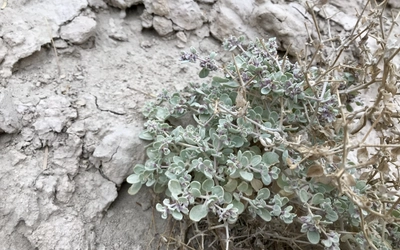Desert plant could hold key to heat-resistant crops

T. oblongifolia growing in Death Valley, California. Photo credit: Karine Prado/Michigan State University
Michigan State University – A plant thriving in the heat of California’s Death Valley could provide lessons to scientists on how to engineer heat-resistant crops.
Researchers at Michigan State University have studied Tidestromia oblongifolia, a shrub that grows faster in the Death Valley summer, when temperatures can exceed 50 degrees Celsius. Despite the extreme conditions, the plant stayed green and grew by adjusting its own photosynthetic system to withstand the high temperatures.
When MSU scientists brought T. oblongifolia seeds back to their lab, it failed to grow in more temperate conditions and only started when Death Valley conditions were replicated in growth chambers. They found that the plant’s mitochondria repositioned themselves next to the chloroplasts where photosynthesis occurs. The chloroplasts change into a “cup-like” shape to capture and recycle carbon dioxide, while thousands of its genes switched activities within 24 hours.
In two days, the plant’s optimal photosynthetic temperature was 45 C, the highest recorded by any crop species. In 10 days, its biomass tripled.
“This is the most heat-tolerant plant ever documented,” MSU Research Foundation Professor Seung Yon “Sue” Rhee said. “Understanding how T. oblongifolia acclimates to heat gives us new strategies to help crops adapt to a warming planet.”
As heat continues to cut the yields of corn, soybeans, wheat and other staple crops worldwide, with temperatures expected to rise up to five degrees Celsius by the end of the century, Rhee believes science now has the tools to add heat-resistant genes to certain crops.
“Desert plants have spent millions of years solving the challenges we’re only beginning to face,” she said. “We finally have the tools, such as genomics, high-resolution live imaging and systems biology, to learn from them.”


